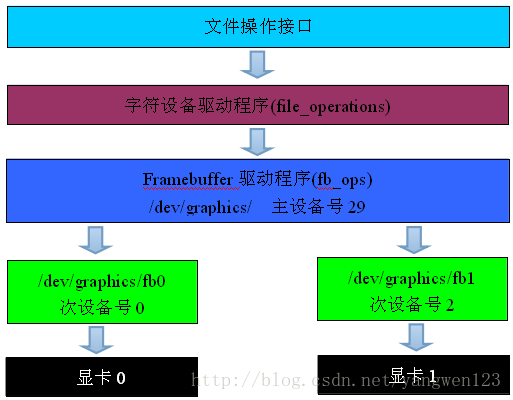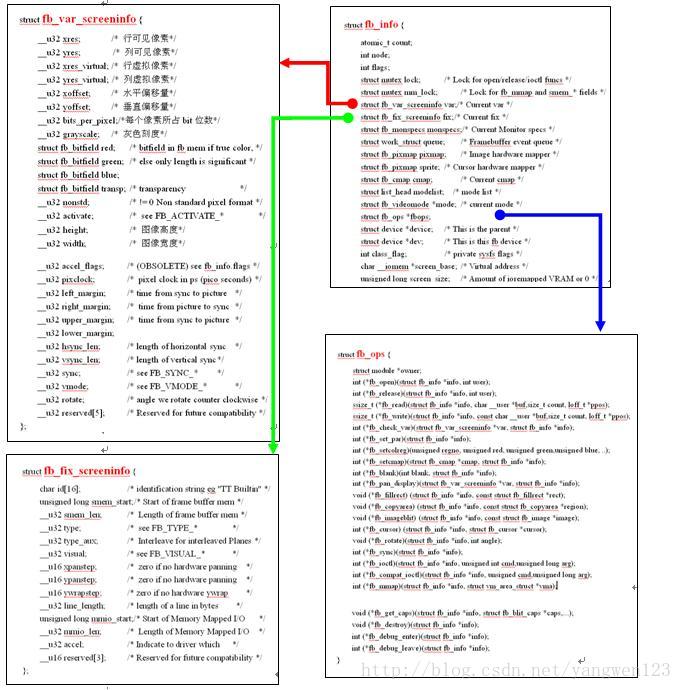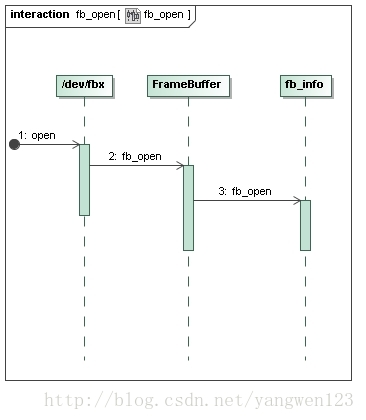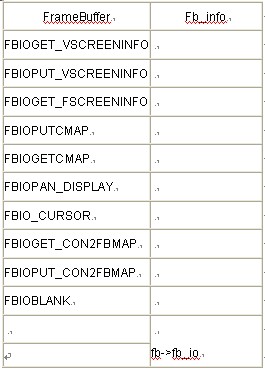FrameBuffer通常作为LCD控制器或者其他显示设备的驱动,FrameBuffer驱动是一个字符设备,设备节点是/dev/fbX,主设备号为29,次设备号递增,用户可以将Framebuffer看成是显示内存的一个映像,将其映射到进程地址空间之后,就可以直接进行读写操作,而写操作可以立即反应在屏幕上。这种操作是抽象的,统一的。用户不必关心物理显存的位置、换页机制等等具体细节。这些都是由Framebuffer设备驱动来完成的。Framebuffer设备为上层应用程序提供系统调用,也为下一层的特定硬件驱动提供接口;那些底层硬件驱动需要用到这儿的接口来向系统内核注册它们自己。

Linux中的PCI设备可以将其控制寄存器映射到物理内存空间,而后,对这些控制寄存器的访问变成了对物理内存的访问,因此,这些寄存器又被称为”memio”。一旦被映射到物理内存,Linux的普通进程就可以通过mmap将这些内存I/O映射到进程地址空间,这样就可以直接访问这些寄存器了。
FrameBuffer设备属于字符设备,采用了文件层—驱动层的接口方式,Linux为帧缓冲设备定义了驱动层的接口fb_info结构,在文件层上,用户调用file_operations的函数操作,间接调用fb_info中的fb_ops函数集来操作硬件。
Framebuffer数据结构
kernel\include\linux\fb.h
fb_info是Linux为帧缓冲设备定义的驱动层接口。它不仅包含了底层函数,而且还有记录设备状态的数据。每个帧缓冲设备都与一个fb_info结构相对应。
|
1 2 3 4 5 6 7 8 9 10 11 12 13 14 15 16 17 18 19 20 21 22 23 24 25 26 27 28 29 30 31 32 33 34 35 36 37 38 39 40 41 42 43 44 45 46 47 48 |
struct fb_info { atomic_t count; int node; /*一个FrameBuffer设备的次设备号*/ int flags; struct mutex lock; /* Lock for open/release/ioctl funcs */ struct mutex mm_lock; /* Lock for fb_mmap and smem_* fields */ struct fb_var_screeninfo var;/* Current var */ struct fb_fix_screeninfo fix;/* Current fix */ struct fb_monspecs monspecs;/* Current Monitor specs */ struct work_struct queue; /* Framebuffer event queue */ struct fb_pixmap pixmap; /* Image hardware mapper */ struct fb_pixmap sprite; /* Cursor hardware mapper */ struct fb_cmap cmap; /* Current cmap */ struct list_head modelist; /* mode list */ struct fb_videomode *mode; /* current mode */ #ifdef CONFIG_FB_BACKLIGHT struct backlight_device *bl_dev; /* Backlight level curve */ struct mutex bl_curve_mutex; u8 bl_curve[FB_BACKLIGHT_LEVELS]; #endif #ifdef CONFIG_FB_DEFERRED_IO struct delayed_work deferred_work; struct fb_deferred_io *fbdefio; #endif struct fb_ops *fbops; struct device *device; /* This is the parent */ struct device *dev; /* This is this fb device */ int class_flag; /* private sysfs flags */ #ifdef CONFIG_FB_TILEBLITTING struct fb_tile_ops *tileops;/* Tile Blitting */ #endif char __iomem *screen_base; /* Virtual address */ unsigned long screen_size; /* Amount of ioremapped VRAM or 0 */ void *pseudo_palette; /* Fake palette of 16 colors */ #define FBINFO_STATE_RUNNING 0 #define FBINFO_STATE_SUSPENDED 1 u32 state; /* Hardware state i.e suspend */ void *fbcon_par; /* fbcon use-only private area */ void *par; struct apertures_struct { unsigned int count; struct aperture { resource_size_t base; resource_size_t size; } ranges[0]; } *apertures; }; |
fb_var_screeninfo:用于记录用户可修改的显示控制器参数,包括屏幕分辨率、每个像素点的比特数等
|
1 2 3 4 5 6 7 8 9 10 11 12 13 14 15 16 17 18 19 20 21 22 23 24 25 26 27 28 29 30 |
struct fb_var_screeninfo { __u32 xres; /* 行可见像素*/ __u32 yres; /* 列可见像素*/ __u32 xres_virtual; /* 行虚拟像素*/ __u32 yres_virtual; /* 列虚拟像素*/ __u32 xoffset; /* 水平偏移量*/ __u32 yoffset; /* 垂直偏移量*/ __u32 bits_per_pixel;/*每个像素所占bit位数*/ __u32 grayscale; /* 灰色刻度*/ struct fb_bitfield red; /* bitfield in fb mem if true color, */ struct fb_bitfield green; /* else only length is significant */ struct fb_bitfield blue; struct fb_bitfield transp; /* transparency */ __u32 nonstd; /* != 0 Non standard pixel format */ __u32 activate; /* see FB_ACTIVATE_* */ __u32 height; /* 图像高度*/ __u32 width; /* 图像宽度*/ __u32 accel_flags; /* (OBSOLETE) see fb_info.flags */ __u32 pixclock; /* pixel clock in ps (pico seconds) */ __u32 left_margin; /* time from sync to picture */ __u32 right_margin; /* time from picture to sync */ __u32 upper_margin; /* time from sync to picture */ __u32 lower_margin; __u32 hsync_len; /* length of horizontal sync */ __u32 vsync_len; /* length of vertical sync */ __u32 sync; /* see FB_SYNC_* */ __u32 vmode; /* see FB_VMODE_* */ __u32 rotate; /* angle we rotate counter clockwise */ __u32 reserved[5]; /* Reserved for future compatibility */ }; |
fb_fix_screeninfo:记录了用户不能修改的显示控制器的参数,这些参数是在驱动初始化时设置的
|
1 2 3 4 5 6 7 8 9 10 11 12 13 14 15 16 |
struct fb_fix_screeninfo { char id[16]; /* identification string eg "TT Builtin" */ unsigned long smem_start;/* Start of frame buffer mem */ __u32 smem_len; /* Length of frame buffer mem */ __u32 type; /* see FB_TYPE_* */ __u32 type_aux; /* Interleave for interleaved Planes */ __u32 visual; /* see FB_VISUAL_* */ __u16 xpanstep; /* zero if no hardware panning */ __u16 ypanstep; /* zero if no hardware panning */ __u16 ywrapstep; /* zero if no hardware ywrap */ __u32 line_length; /* length of a line in bytes */ unsigned long mmio_start;/* Start of Memory Mapped I/O */ __u32 mmio_len; /* Length of Memory Mapped I/O */ __u32 accel; /* Indicate to driver which */ __u16 reserved[3]; /* Reserved for future compatibility */ }; |
fb_ops是提供给底层设备驱动的一个接口。当我们编写一个FrameBuffer的时候,就要依照Linux FrameBuffer编程的套路,填写fb_ops结构体。
|
1 2 3 4 5 6 7 8 9 10 11 12 13 14 15 16 17 18 19 20 21 22 23 24 25 26 27 28 29 30 31 32 33 34 35 36 37 38 39 40 41 42 43 44 45 46 47 48 49 50 51 52 53 54 55 56 57 58 59 60 61 62 63 64 65 66 67 68 69 70 71 72 |
struct fb_ops { /* open/release and usage marking */ struct module *owner; int (*fb_open)(struct fb_info *info, int user); int (*fb_release)(struct fb_info *info, int user); /* For framebuffers with strange non linear layouts or that do not * work with normal memory mapped access */ ssize_t (*fb_read)(struct fb_info *info, char __user *buf, size_t count, loff_t *ppos); ssize_t (*fb_write)(struct fb_info *info, const char __user *buf, size_t count, loff_t *ppos); /* checks var and eventually tweaks it to something supported, * DO NOT MODIFY PAR */ int (*fb_check_var)(struct fb_var_screeninfo *var, struct fb_info *info); /* set the video mode according to info->var */ int (*fb_set_par)(struct fb_info *info); /* set color register */ int (*fb_setcolreg)(unsigned regno, unsigned red, unsigned green, unsigned blue, unsigned transp, struct fb_info *info); /* set color registers in batch */ int (*fb_setcmap)(struct fb_cmap *cmap, struct fb_info *info); /* blank display */ int (*fb_blank)(int blank, struct fb_info *info); /* pan display */ int (*fb_pan_display)(struct fb_var_screeninfo *var, struct fb_info *info); /* Draws a rectangle */ void (*fb_fillrect) (struct fb_info *info, const struct fb_fillrect *rect); /* Copy data from area to another */ void (*fb_copyarea) (struct fb_info *info, const struct fb_copyarea *region); /* Draws a image to the display */ void (*fb_imageblit) (struct fb_info *info, const struct fb_image *image); /* Draws cursor */ int (*fb_cursor) (struct fb_info *info, struct fb_cursor *cursor); /* Rotates the display */ void (*fb_rotate)(struct fb_info *info, int angle); /* wait for blit idle, optional */ int (*fb_sync)(struct fb_info *info); /* perform fb specific ioctl (optional) */ int (*fb_ioctl)(struct fb_info *info, unsigned int cmd, unsigned long arg); /* Handle 32bit compat ioctl (optional) */ int (*fb_compat_ioctl)(struct fb_info *info, unsigned cmd, unsigned long arg); /* perform fb specific mmap */ int (*fb_mmap)(struct fb_info *info, struct vm_area_struct *vma); /* get capability given var */ void (*fb_get_caps)(struct fb_info *info, struct fb_blit_caps *caps, struct fb_var_screeninfo *var); /* teardown any resources to do with this framebuffer */ void (*fb_destroy)(struct fb_info *info); /* called at KDB enter and leave time to prepare the console */ int (*fb_debug_enter)(struct fb_info *info); int (*fb_debug_leave)(struct fb_info *info); }; |

Framebuffer模块初始化过程
FrameBuffer驱动是以模块的形式注册到系统中,在模块初始化时,创建FrameBuffer对应的设备文件及proc文件,并注册FrameBuffer设备操作接口函数。
kernel\drivers\video\Fbmem.c
|
1 2 3 4 5 6 7 8 9 10 11 12 13 14 15 16 17 |
module_init(fbmem_init); static int __init fbmem_init(void) { //在proc文件系统中创建/proc/fb文件,并注册proc接口函数 proc_create("fb", 0, NULL, &fb_proc_fops); //注册字符设备fb,并注册fb设备文件的操作接口函数,主设备号为29, //#define FB_MAJOR 29 if (register_chrdev(FB_MAJOR,"fb",&fb_fops)) printk("unable to get major %d for fb devs\n", FB_MAJOR); //创建sys/class/graphics目录 fb_class = class_create(THIS_MODULE, "graphics"); if (IS_ERR(fb_class)) { printk(KERN_WARNING "Unable to create fb class; errno = %ld\n", PTR_ERR(fb_class)); fb_class = NULL; } return 0; } |
首先在proc文件系统中创建fb文件,同时注册操作该文件的接口函数:
|
1 2 3 4 5 6 7 |
static const struct file_operations fb_proc_fops = { .owner = THIS_MODULE, .open = proc_fb_open, .read = seq_read, .llseek = seq_lseek, .release = seq_release, }; |
因此可以对/proc/fb文件进行打开,读写操作。然后注册一个主设备号为29的字符设备,fbmem_init函数中注册了字符设备的文件操作接口函数fb_fops,定义如下:
|
1 2 3 4 5 6 7 8 9 10 11 12 13 14 15 16 17 18 19 |
static const struct file_operations fb_fops = { .owner =THIS_MODULE, .read = fb_read, .write = fb_write, .unlocked_ioctl = fb_ioctl, #ifdef CONFIG_COMPAT .compat_ioctl = fb_compat_ioctl, #endif .mmap = fb_mmap, .open = fb_open, .release =fb_release, #ifdef HAVE_ARCH_FB_UNMAPPED_AREA .get_unmapped_area = get_fb_unmapped_area, #endif #ifdef CONFIG_FB_DEFERRED_IO .fsync =fb_deferred_io_fsync, #endif .llseek =default_llseek, }; |
Framebuffer驱动注册过程
变量定义:
|
1 2 3 4 |
//保存注册的所有Framebuffer驱动 extern struct fb_info *registered_fb[FB_MAX]; //已注册的Framebuffer驱动的个数 extern int num_registered_fb; |
任何一个特定硬件Framebuffer驱动在初始化时都必须向fbmem.c注册,FrameBuffer模块提供了驱动注册接口函数register_framebuffer:
|
1 2 3 4 5 6 7 8 |
int register_framebuffer(struct fb_info *fb_info) { int ret; mutex_lock(istration_lock); ret = do_register_framebuffer(fb_info); mutex_unlock(istration_lock); return ret; } |
参数fb_info描述特定硬件的FrameBuffer驱动信息
|
1 2 3 4 5 6 7 8 9 10 11 12 13 14 15 16 17 18 19 20 21 22 23 24 25 26 27 28 29 30 31 32 33 34 35 36 37 38 39 40 41 42 43 44 45 46 47 48 49 50 51 52 53 54 55 56 57 58 59 60 61 62 |
static int do_register_framebuffer(struct fb_info *fb_info) { int i; struct fb_event event; struct fb_videomode mode; if (fb_check_foreignness(fb_info)) return -ENOSYS; //根据当前注册的fb_info的apertures属性从FrameBuffer驱动数组registered_fb中查询是否存在冲突 do_remove_conflicting_framebuffers(fb_info->apertures, fb_info->fix.id, fb_is_primary_device(fb_info)); //判断已注册的驱动是否超过32个FrameBuffer驱动 if (num_registered_fb == FB_MAX) return -ENXIO; //增加已注册的驱动个数 num_registered_fb++; //从数组registered_fb中查找空闲元素,用于存储当前注册的fb_info for (i = 0 ; i < FB_MAX; i++) if (!registered_fb[i]) break; //将当前注册的fb_info在数组registered_fb中的索引位置保存到fb_info->node fb_info->node = i; //初始化当前注册的fb_info的成员信息 atomic_set(&fb_info->count, 1); mutex_init(&fb_info->lock); mutex_init(&fb_info->mm_lock); //在/dev目录下创建一个fbx的设备文件,次设备号就是该fb_info在数组registered_fb中的索引 fb_info->dev = device_create(fb_class, fb_info->device,MKDEV(FB_MAJOR, i), NULL, "fb%d", i); if (IS_ERR(fb_info->dev)) { printk(KERN_WARNING "Unable to create device for framebuffer %d; errno = %ld\n", i, PTR_ERR(fb_info->dev)); fb_info->dev = NULL; } else //初始化fb_info fb_init_device(fb_info); if (fb_info->pixmap.addr == NULL) { fb_info->pixmap.addr = kmalloc(FBPIXMAPSIZE, GFP_KERNEL); if (fb_info->pixmap.addr) { fb_info->pixmap.size = FBPIXMAPSIZE; fb_info->pixmap.buf_align = 1; fb_info->pixmap.scan_align = 1; fb_info->pixmap.access_align = 32; fb_info->pixmap.flags = FB_PIXMAP_DEFAULT; } } fb_info->pixmap.offset = 0; if (!fb_info->pixmap.blit_x) fb_info->pixmap.blit_x = ~(u32)0; if (!fb_info->pixmap.blit_y) fb_info->pixmap.blit_y = ~(u32)0; if (!fb_info->modelist.prev || !fb_info->modelist.next) INIT_LIST_HEAD(&fb_info->modelist); fb_var_to_videomode(&mode, &fb_info->var); fb_add_videomode(&mode, &fb_info->modelist); //将特定硬件对应的fb_info注册到registered_fb数组中 registered_fb[i] = fb_info; event.info = fb_info; if (!lock_fb_info(fb_info)) return -ENODEV; //使用Linux事件通知机制发送一个FrameBuffer注册事件FB_EVENT_FB_REGISTERED fb_notifier_call_chain(FB_EVENT_FB_REGISTERED, &event); unlock_fb_info(fb_info); return 0; } |
注册过程就是将指定的设备驱动信息fb_info存放到registered_fb数组中。因此在注册具体的fb_info时,首先要构造一个fb_info数据结构,并初始化该数据结构,该结构用于描述一个特定的FrameBuffer驱动。
fbX设备文件的打开过程
open(“/dev/fb0”)打开设备文件fb0对应的操作过程如下:
|
1 2 3 4 5 6 7 8 9 10 11 12 13 14 15 16 17 18 19 20 21 22 23 24 25 26 27 28 29 30 31 32 33 34 35 36 37 38 39 40 41 |
static int fb_open(struct inode *inode, struct file *file) __acquires(&info->lock) __releases(&info->lock) { //从文件节点中取得次设备号 int fbidx = iminor(inode); struct fb_info *info; int res = 0; //根据次设备号从registered_fb数组中取出对应的fb_info info = get_fb_info(fbidx); if (!info) { request_module("fb%d", fbidx); info = get_fb_info(fbidx); if (!info) return -ENODEV; } if (IS_ERR(info)) return PTR_ERR(info); mutex_lock(&info->lock); if (!try_module_get(info->fbops->owner)) { res = -ENODEV; goto out; } //将当前的fb_info保存到/dev/fbx设备文件的private_data成员中 file->private_data = info; if (info->fbops->fb_open) { //调用当前fb_info的fb_open函数打开当前FrameBuffer设备 res = info->fbops->fb_open(info,1); if (res) module_put(info->fbops->owner); } #ifdef CONFIG_FB_DEFERRED_IO if (info->fbdefio) fb_deferred_io_open(info, inode, file); #endif out: mutex_unlock(&info->lock); if (res) put_fb_info(info); return res; } |
打开过程很简单,首先从文件节点中取出要打开FrameBuffer的fb_info数据信息,并保存到设备文件file的private_data变量中,然后调用当前fb_info中的fb_open函数完成设备打开过程。该函数在构造具体的fb_info并注册FrameBuffer时,就已注册了对应的打开操作函数指针。

fbX设备文件的映射过程
|
1 2 3 4 5 6 7 8 9 10 11 12 13 14 15 16 17 18 19 20 21 22 23 24 25 26 27 28 29 30 31 32 33 34 35 36 37 38 39 40 41 42 43 44 45 46 47 48 49 50 51 52 |
static int fb_mmap(struct file *file, struct vm_area_struct * vma) { //从文件节点中取出fb_info,并且判断是否和private_data变量中的fb_info相同 struct fb_info *info = file_fb_info(file); struct fb_ops *fb; unsigned long off; unsigned long start; u32 len; if (!info) return -ENODEV; if (vma->vm_pgoff > (~0UL >> PAGE_SHIFT)) return -EINVAL; off = vma->vm_pgoff << PAGE_SHIFT; fb = info->fbops; if (!fb) return -ENODEV; mutex_lock(&info->mm_lock); //如果fb_info中注册了fb_mmap函数,则调用fb_info中的fb_mmap来完成地址空间映射 if (fb->fb_mmap) { int res; res = fb->fb_mmap(info, vma); mutex_unlock(&info->mm_lock); return res; } //如果具体的fb_info没有实现fb_mmap start = info->fix.smem_start; len = PAGE_ALIGN((start & ~PAGE_MASK) + info->fix.smem_len); if (off >= len) { /* memory mapped io */ off -= len; if (info->var.accel_flags) { mutex_unlock(&info->mm_lock); return -EINVAL; } start = info->fix.mmio_start; len = PAGE_ALIGN((start & ~PAGE_MASK) + info->fix.mmio_len); } mutex_unlock(&info->mm_lock); start &= PAGE_MASK; if ((vma->vm_end - vma->vm_start + off) > len) return -EINVAL; off += start; vma->vm_pgoff = off >> PAGE_SHIFT; /* This is an IO map - tell maydump to skip this VMA */ vma->vm_flags |= VM_IO | VM_RESERVED; vma->vm_page_prot = vm_get_page_prot(vma->vm_flags); fb_pgprotect(file, vma, off); if (io_remap_pfn_range(vma, vma->vm_start, off >> PAGE_SHIFT, vma->vm_end - vma->vm_start, vma->vm_page_prot)) return -EAGAIN; return 0; } |
这里和fb打开过程类似,仍然是调用具体的fb_info的映射函数来完成地址空间映射过程,但是也有区别,就是在具体的fb_info没有实现地址空间映射时,就在FrameBuffer这一层完成映射过程。
fbX设备文件的命令控制过程

|
1 2 3 4 5 6 7 8 9 10 11 12 13 14 15 16 17 18 19 20 21 22 23 24 25 26 27 28 29 30 31 32 33 34 35 36 37 38 39 40 41 42 43 44 45 46 47 48 49 50 51 52 53 54 55 56 57 58 59 60 61 62 63 64 65 66 67 68 69 70 71 72 73 74 75 76 77 78 79 80 81 82 83 84 85 86 87 88 89 90 91 92 93 94 95 96 97 98 99 100 101 102 103 104 105 106 107 108 109 110 111 112 113 114 115 116 117 118 119 120 121 122 123 124 125 126 127 |
static long do_fb_ioctl(struct fb_info *info, unsigned int cmd,unsigned long arg) { struct fb_ops *fb; struct fb_var_screeninfo var; struct fb_fix_screeninfo fix; struct fb_con2fbmap con2fb; struct fb_cmap cmap_from; struct fb_cmap_user cmap; struct fb_event event; void __user *argp = (void __user *)arg; long ret = 0; switch (cmd) { case FBIOGET_VSCREENINFO: if (!lock_fb_info(info)) return -ENODEV; var = info->var; unlock_fb_info(info); ret = copy_to_user(argp, &var, sizeof(var)) ? -EFAULT : 0; break; case FBIOPUT_VSCREENINFO: if (copy_from_user(&var, argp, sizeof(var))) return -EFAULT; if (!lock_fb_info(info)) return -ENODEV; console_lock(); info->flags |= FBINFO_MISC_USEREVENT; ret = fb_set_var(info, &var); info->flags &= ~FBINFO_MISC_USEREVENT; console_unlock(); unlock_fb_info(info); if (!ret && copy_to_user(argp, &var, sizeof(var))) ret = -EFAULT; break; case FBIOGET_FSCREENINFO: if (!lock_fb_info(info)) return -ENODEV; fix = info->fix; unlock_fb_info(info); ret = copy_to_user(argp, &fix, sizeof(fix)) ? -EFAULT : 0; break; case FBIOPUTCMAP: if (copy_from_user(&cmap, argp, sizeof(cmap))) return -EFAULT; ret = fb_set_user_cmap(&cmap, info); break; case FBIOGETCMAP: if (copy_from_user(&cmap, argp, sizeof(cmap))) return -EFAULT; if (!lock_fb_info(info)) return -ENODEV; cmap_from = info->cmap; unlock_fb_info(info); ret = fb_cmap_to_user(&cmap_from, &cmap); break; case FBIOPAN_DISPLAY: if (copy_from_user(&var, argp, sizeof(var))) return -EFAULT; if (!lock_fb_info(info)) return -ENODEV; console_lock(); ret = fb_pan_display(info, &var); console_unlock(); unlock_fb_info(info); if (ret == 0 && copy_to_user(argp, &var, sizeof(var))) return -EFAULT; break; case FBIO_CURSOR: ret = -EINVAL; break; case FBIOGET_CON2FBMAP: if (copy_from_user(&con2fb, argp, sizeof(con2fb))) return -EFAULT; if (con2fb.console < 1 || con2fb.console > MAX_NR_CONSOLES) return -EINVAL; con2fb.framebuffer = -1; event.data = &con2fb; if (!lock_fb_info(info)) return -ENODEV; event.info = info; fb_notifier_call_chain(FB_EVENT_GET_CONSOLE_MAP, &event); unlock_fb_info(info); ret = copy_to_user(argp, &con2fb, sizeof(con2fb)) ? -EFAULT : 0; break; case FBIOPUT_CON2FBMAP: if (copy_from_user(&con2fb, argp, sizeof(con2fb))) return -EFAULT; if (con2fb.console < 1 || con2fb.console > MAX_NR_CONSOLES) return -EINVAL; if (con2fb.framebuffer < 0 || con2fb.framebuffer >= FB_MAX) return -EINVAL; if (!registered_fb[con2fb.framebuffer]) request_module("fb%d", con2fb.framebuffer); if (!registered_fb[con2fb.framebuffer]) { ret = -EINVAL; break; } event.data = &con2fb; if (!lock_fb_info(info)) return -ENODEV; event.info = info; ret = fb_notifier_call_chain(FB_EVENT_SET_CONSOLE_MAP, &event); unlock_fb_info(info); break; case FBIOBLANK: if (!lock_fb_info(info)) return -ENODEV; console_lock(); info->flags |= FBINFO_MISC_USEREVENT; ret = fb_blank(info, arg); info->flags &= ~FBINFO_MISC_USEREVENT; console_unlock(); unlock_fb_info(info); break; default: if (!lock_fb_info(info)) return -ENODEV; fb = info->fbops; if (fb->fb_ioctl) ret = fb->fb_ioctl(info, cmd, arg); else ret = -ENOTTY; unlock_fb_info(info); } return ret; } |
FrameBuffer驱动的框架就介绍到这来,总结一下:
- 构建一个fb_info数据结构,用来描述帧缓冲设备;
- 调用FrameBuffer驱动模块提供的接口函数register_framebuffer来注册帧缓冲设备;
- 对FrameBuffer设备文件的操作过程是,首先执行FrameBuffer驱动函数,然后根据注册的帧缓冲设备的次设备号得到注册的fb_info,最后调用具体的帧缓冲设备的操作函数;
转载自:https://blog.csdn.net/yangwen123/article/details/12096483
